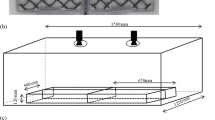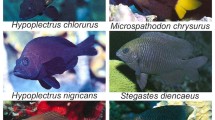Abstract
Individuals within groups benefit when they are phenotypically and behaviourally similar. Despite this, mixed-species aggregations are found among a wide range of animal taxa and are known to provide advantages in terms of enhanced foraging efficiency and predator avoidance. However, little is known about individual level interactions within these groups or the mechanisms mediating their structure. Diet-derived chemical cues can mediate within-species associations in fish, but it is not known whether they serve a similar function across species. To investigate this, we created mixed-species groups of sympatric three-spined (Gasterosteus aculeatus) and nine-spined (Pungitius pungitius) sticklebacks and manipulated the diet of the constituent group members. We found that three-spined sticklebacks did not associate more frequently with conspecifics over heterospecifics when all animals received the same diet, suggesting that species-specific cues did not influence association patterns. However, when group members were fed different diets, they interacted with heterospecifics fed on the same diet more than with conspecifics from a different diet treatment. This study demonstrates the importance of chemical cues as a possible mechanism for establishing familiarity, and thereby mediating within-group structure even between individuals in mixed-species aggregations. Understanding these underlying mechanisms has significant implications for our understanding of other social dynamics, including social learning and information transfer.
Significance statement
Mixed-species groupings are common among animals, although we have a poor understanding of how these groups are structured, what mediates interactions between group members, and what the function of such groups is. In a study using two co-occurring stickleback species, we show that fish preferred to associate with shoal members fed the same diet as themselves, irrespective of their species. This is most likely mediated by diet-derived chemical cues and may allow fish to avoid detection by predators or forage alongside individuals with similar dietary preferences. Understanding the mechanisms underpinning non-random associations in mixed-species groups has significant implications for our understanding of other social dynamics, including social learning and information transfer.



Similar content being viewed by others
References
Allan JR, Pitcher TJ (1986) Species segregation during predator evasion in cyprinid fish shoals. Freshw Biol 16:653–659
Atema J, Holland K, Ikehara W (1980) Olfactory responses of yellowfin tuna (Thunnus albacares) top prey odors: chemical search images. J Chem Ecol 6:457–465
Bonadonna F, Miguel E, Grosbois V, Jouventin P, Bessiere JM (2007) Individual odor recognition in birds: an endogenous olfactory signature on petrels’ feathers? J Chem Ecol 33:1819–1829
Chivers DP, Brown GE, Smith RJF (1995) Familiarity and shoal cohesion in fathead minnows (Pimephales promelas): implications for antipredator behaviour. Can J Zool 73:955–960
Clark JA, Boersma PD, Olmsted DM (2006) Name that tune: call discrimination and individual recognition in Magellanic penguins. Anim Behav 72:1141–1148
Conradt L, Roper TJ (2000) Activity synchrony and social cohesion: a fission-fusion model. Proc R Soc Lond B 267:2213–2218
Errard C, Hefetz A (1997) Label familiarity and discriminatory ability of ants reared in mixed groups. Insect Soc 44:189–198
Farine DR (2014) Measuring phenotypic assortment in animal social networks: weighted associations are more robust than binary edges. Anim Behav 89:141–153
Farine DR, Milburn PJ (2013) Social organisation of thornbill-dominated mixed-species flocks using social network analysis. Behav Ecol Sociobiol 67:321–330
Farine DR, Downing CP, Downing PA (2014) Mixed-species associations can arise without heterospecific attraction. Behav Ecol 25:574–581
Fauconneau B, Saglio P (1984) Protein-bound and free amino acid content in the skin mucus of the European eel, Anguilla anguilla (L.). Comp Biochem Phys B 77:513–516
FitzGerald GJ, Morrissette J (1992) Kin recognition and choice of shoal mates by three-spine sticklebacks. Ethol Ecol Evol 4:273–283
Goodale E, Beauchamp G, Magrath RD, Nieh JC, Ruxton GD (2010) Interspecific information transfer influences animal community structure. Trends Ecol Evol 25:354–361
Griffiths SW, Ward AJW (2011) Social recognition of conspecifics. In: Brown C, Laland K, Krause J (eds) Fish cognition and behavior. Wiley, New York, pp 186–216
Kleinhappel TK, Al-Zoubi A, Al-Diri B, Burman O, Dickinson P, John L, Wilkinson A, Pike TW (2014a) A method for the automated long-term monitoring of three-spined stickleback Gasterosteus aculeatus shoal dynamics. J Fish Biol 84:1228–1233
Kleinhappel TK, Burman O, John L, Wilkinson A, Pike TW (2014b) Diet mediated social networks in shoaling fish. Behav Ecol 25:374–377
Krause J, Godin J-GJ (1994) Shoal choice in the banded killifish (Fundulus diaphanus, Teleostei, Cyprinodontidae): effects of predation risk, fish size, species composition and size of shoals. Ethology 98:128–136
Krause J, Ruxton GD (2002) Living in groups. Oxford University Press, London
Landeau L, Terborgh J (1986) Oddity and the “confusion effect” in predation. Anim Behav 34:1372–1380
Mathis A, Chivers DP (2003) Overriding the oddity effect in mixed-species aggregations: group choice by armoured and nonarmoured prey. Behav Ecol 14:334–339
Menzel F, Linsenmair KE, Blüthgen N (2008) Selective interspecific tolerance in tropical Crematogaster – Camponotus associations. Anim Behav 75:837–846
Ohguchi O (1978) Experiments on the selection against colour oddity of water fleas by three‐spined sticklebacks. Z Tierpsychol 47:254–267
Pitcher TJ, Parrish JK (1993) Functions of shoaling behaviour in teleosts. In: Pitcher TJ (ed) Behaviour of teleost fishes. Chapman and Hall, New York, pp 363–439
Rodgers GM, Kimbell H, Morrell LJ (2013) Mixed phenotype grouping: the interaction between oddity and crypsis. Oecologia 172:59–68
Saglio P, Fauconneau B (1985) Free amino acid content in the skin mucus of goldfish, Carassius auratus L.: influence of feeding. Comp Biochem Phys B 82:67–70
Seppänen J, Forsman JT, Mönkkönen M, Thomson RL (2007) Social information use is a process across time, space, and ecology, reaching heterospecifics. Ecology 88:1622–1633
Silverman ED, Veit RR, Nevitt GA (2004) Nearest neighbors as foraging cues: information transfer in a patchy environment. Mar Ecol-Prog Ser 277:25–35
Snijders TAB, Borgatti SP (1999) Non-parametric standard errors and tests for network statistics. Connections 22:61–70
Stamps JA (1988) Conspecific attraction and aggregation in territorial species. Am Nat 131:329–347
Stephan C, Wilkinson A, Huber L (2012) Have we met before? Pigeons recognise familiar human faces. Avian Biol Res 5:75–80
Swaney W, Kendal J, Capon H, Brown C, Laland LN (2001) Familiarity facilitates social learning of foraging behaviour in the guppy. Anim Behav 62:591–598
Szulkin M, Dawidowicz P, Dodson SI (2006) Behavioural uniformity as a response to cues of predation risk. Anim Behav 71:1013–1019
Theodorakis CW (1989) Size segregation and the effects of oddity on predation risk in minnow schools. Anim Behav 38:496–502
Tosh CR, Jackson AL, Ruxton GD (2007) Individuals from different-looking animal species may group together to confuse shared predators: simulations with artificial neural networks. Proc R Soc Lond B 274:827–832
Utne-Palm AC, Hart PJB (2000) The effects of familiarity on competitive interactions between threespined sticklebacks. Oikos 91:225–232
Valentincic T, Metelko J, Ota D, Pirc V, Blejec A (2000) Olfactory discrimination of amino acids in brown bullhead catfish. Chem Senses 25:21–29
Valentincic T, Miklavc P, Kralj S, Zgonik V (2011) Olfactory discrimination of complex mixtures of amino acids by black bullhead Ameiurus melas. J Fish Biol 79:33–52
Warburton K, Lees N (1996) Species discrimination in guppies: learned responses to visual cues. Anim Behav 52:371–378
Ward AJW, Hart PJB (2003) The effects of kin and familiarity on interactions between fish. Fish Fish 4:348–358
Ward AJW, Axford S, Krause J (2002) Mixed-species shoaling in fish: the sensory mechanisms and costs of shoal choice. Behav Ecol Sociobiol 52:182–187
Ward AJW, Axford S, Krause J (2003) Cross–species familiarity in shoaling fishes. Proc R Soc Lond B 270:1157–1161
Ward AJW, Hart PJB, Krause J (2004) The effects of habitat-and diet-based cues on association preferences in three-spined sticklebacks. Behav Ecol 15:925–929
Ward AJW, Holbrook RI, Krause J, Hart PJB (2005) Social recognition in sticklebacks: the role of direct experience and habitat cues. Behav Ecol Sociobiol 57:575–583
Ward AJW, Webster MM, Magurran AE, Currie S, Krause J (2009) Species and population differences in social recognition between fishes: a role for ecology? Behav Ecol 20:511–516
Wascher CAF, Szipl G, Boeckle M, Wilkinson A (2012) You sound familiar: carrion crows can differentiate between the calls of known and unknown heterospecifics. Anim Cogn 15:1015–1019
Webster MM, Laland K (2009) Evaluation of a non-invasive tagging system for laboratory studies using three-spined sticklebacks. J Fish Biol 75:1868–1873
Webster MM, Goldsmith J, Ward AJW, Hart PJB (2007) Habitat-specific chemical cues influence association preferences and shoal cohesion in fish. Behav Ecol Sociobiol 62:273–280
Webster MM, Ward AJW, Hart PJB (2008) Individual boldness affects interspecific interactions in sticklebacks. Behav Ecol Sociobiol 63:511–520
Whiting MJ, Greeff JM (1999) Use of heterospecific cues by the lizard Platysaurus broadleyi for food location. Behav Ecol Sociobiol 45:420–423
Wilkinson A, Specht HL, Huber L (2010) Pigeons can discriminate group mates from strangers using the concept of familiarity. Anim Behav 80:109–115
Windfelder TL (2001) Interspecific communication in mixed-species groups of tamarins: evidence from playback experiments. Anim Behav 61:1193–1201
Wootton RJ (1976) The biology of the sticklebacks. Academic, Waltham
Acknowledgments
We thank W. Hayes for the support in analysing the water samples, D. Simpson for animal husbandry and P. Sriphavatsarakom for providing the photographs. We also thank two anonymous reviewers for their constructive comments which improved the manuscript.
Author information
Authors and Affiliations
Corresponding author
Ethics declarations
All methods used in this study adhered to the ASAB Guidelines for the Use of Animals in Research and gained local institutional ethical approval (UoL 13/45).
Additional information
Communicated by J. Frommen
Rights and permissions
About this article
Cite this article
Kleinhappel, T.K., Burman, O.H.P., John, E.A. et al. A mechanism mediating inter-individual associations in mixed-species groups. Behav Ecol Sociobiol 70, 755–760 (2016). https://doi.org/10.1007/s00265-016-2099-x
Received:
Revised:
Accepted:
Published:
Issue Date:
DOI: https://doi.org/10.1007/s00265-016-2099-x




